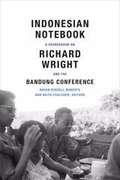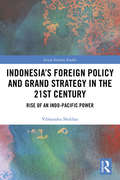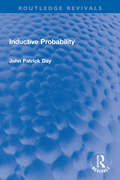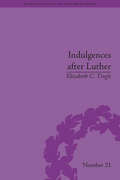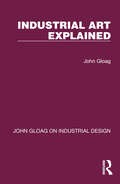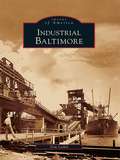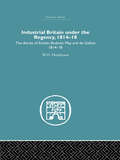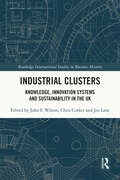- Table View
- List View
Indochina: An Ambiguous Colonization, 1858-1954
by Pierre Brocheux Daniel HémeryCombining new approaches with a groundbreaking historical synthesis, this accessible work is the most thorough and up-to-date general history of French Indochina available in English. Unique in its wide-ranging attention to economic, social, intellectual, and cultural dimensions, it is the first book to treat Indochina's entire history from its inception in Cochinchina in 1858 to its crumbling at Dien Bien Ph in 1954 and on to decolonization. Basing their account on original research as well as on the most recent scholarship, Pierre Brocheux and Daniel Hemery tell this story from a perspective that is neither Eurocentric nor nationalistic but that carefully considers the positions of both the colonizers and the colonized. With this approach, they are able to move beyond descriptive history into a rich exploration of the ambiguities and complexities of the French colonial period in Indochina. Rich in themes and ideas, their account also sheds new light on the national histories of the emerging nation-states of Vietnam, Laos, and Cambodia, making this book essential reading for students, scholars, and general readers interested in the region, in the Vietnam War, or in French imperialism, among other topics.
Indomabile: Trilogia della Seconda Guerra Mondiale, Volume 1
by Marion KummerowBerlino, Germania 1932. In un periodo di tensioni e conflitti politici, un uomo trova il coraggio di battersi… Il Dottor Wilhelm "Q” Quedlin, ingegnere chimico e inventore, vive per la scienza. Una donna non rientra nei suoi programmi e tantomeno essere accusato di spionaggio industriale. Le cose tuttavia prendono una brutta piega. Osservare l’ascesa di Hitler al potere non fa che accrescere il suo desiderio di evitare un’altra guerra che distruggerebbe completamente il suo amato paese. Q prende coscientemente la decisione di combattere contro ciò che sa essere sbagliato, anche se opporsi ai nazisti potrebbe significare morte certa per lui e per chi ama. Hilde Dremmer aveva giurato che non avrebbe più amato. Tuttavia, dopo avere incontrato Q, vuole dare all’amore una seconda possibilità. Quando Q le rivela il suo piano di resistenza, sta a Hilde scegliere tra la sua vita tranquilla senza di lui, oppure la costante minaccia di tortura qualora lo avesse sostenuto nella sua battaglia contro le ingiustizie. Lei ha già assistito a un numero sufficiente di atti violenti del governo nazista, tanto da essere atterrita dal nuovo potere politico, ma ciò sarà sufficiente perché una ragazza comune si comporti in modo straordinario e resti vicino all’uomo che ama in un momento di totale desolazione? Questa spy story al tempo della Seconda Guerra Mondiale si basa sugli eventi reali che videro una coppia combattere per la propria felicità e al contempo lottare contro i propri governanti.
Indomable heredero (Los Preston #Volumen 1)
by Julianne MayCinco hermanos. Una herencia. Una nueva vida en Londres. Leopold Preston detesta Londres, a los nobles y todo lo que ellos representan. Sin embargo, una trágica noticia lo obliga a viajar a aquella ciudad para asumir sus nuevas responsabilidades como barón. Josephine Hamilton, una joven más del montón, se encuentra entre la espada y la pared. La ambición de su padre atenta contra su felicidad, y aunque huir la haría perder la reputación, no encuentra otra salida. La unión de sus destinos parece impensable hasta que una noche y un inesperado acuerdo entre las familias los enredan en la decisión más difícil de sus vidas.
Indomitable: The Life of Barbara Grier
by Joanne Passet"Whatever else will be said about her--and you can bet there will be plenty, because Barbara was no stranger to controversy--the one thing that is true above all else is that she was the most important person in lesbian publishing in the world. Without her boldness and her audacity, there might not be the robust lesbian publishing industry there is today. ” --Teresa DeCrescenzo Barbara Grier--feminist, activist, publisher, and archivist--was many things to different people. Perhaps most well known as one of the founders of Naiad Press, Barbara’s unapologetic drive to make sure that lesbians everywhere had access to books with stories that reflected their lives in positive ways was legendary. Barbara changed the lives of thousands of women in her lifetime. For the first time, historian Joanne Passet uncovers the controversial and often polarizing life of this firebrand editor and publisher with new and never before published letters, interviews, and other personal material from Grier’s own papers. Passet takes readers behind the scenes of The Ladder, offering a rare window onto the isolated and bereft lives lesbians experienced before the feminist movement and during the earliest days of gay political organizing. Through extensive letters between Grier and her friend novelist Jane Rule, Passet offers a virtual diary of this dramatic and repressive era. Passet also looks at Grier’s infamous "theft” of The Ladder’s mailing list, which in turn allowed her to launch and promote Naiad Press, the groundbreaking women’s publishing company she founded with partner Donna McBride in 1973. Naiad went on to become one of the leaders in gay and lesbian book publishing and for years helped sustain lesbian and feminist bookstores--and readers--across the country. JOANNE PASSET is Professor of History Emerita at Indiana University East. Her previous books include Sex Variant Woman: The Life of Jeannette Howard Foster, Sex Radicals and the Quest for Women's Equality, Cultural Crusaders: Women Librarians in the American West, and Aspirations and Mentoring in an Academic Environment (with Mary Niles Maack).
Indomáveis 1: Como Tomámos Conta do Mundo
by Yuval Noah HarariSabias que tens um superpoder? Queres saber qual? Este livro conta-te tudo! Como é que o fogo influenciou a evolução dos nossos estômagos? Sim, leste bem. Estômagos! O que é que o futebol nos diz sobre ser humano? Porque é que o dinheiro é o conto de fadas mais bem-sucedido de sempre? E o que é que isso tudo tem que ver com o facto de sermos a espécie dominante na Terra? Nesta primeira fantástica aventura da série Indomáveis, Yuval Noah Harari revela-te os segredos das origens da humanidade, como nunca antes te contaram. Como tomámos conta do mundo? A resposta está numa das histórias mais fascinantes que alguma vez irás ler!
Indonesia
by Lynda Cohen CassanosIndonesia is an archipelago that includes more than 17,000 islands and stretches across three time zones. It is home to the world's largest Muslim population-more than 200 million Indonesians follow the faith. In 1998 Indonesians replaced the rule of a dictator with democracy, and since then the country has held free and open elections for president as well as for members of a national assembly. However, Indonesia is not without problems, particularly poverty and corruption. There is an armed separatist movement in Aceh, and Islamist terrorist groups like al-Qaeda have targeted Westerners on Bali. This book examines the economic and political issues facing Indonesia today. It provides up-to-date information about the country's geography and climate, history, society, important cities and communities, and relations with other countries
Indonesia's Islamic Revolution
by Kevin W. FoggThe history of the Indonesian Revolution has been dominated by depictions of grassroots fighters and elite politicians who thought of it as a nationalistic or class-based war. In this major new study, Kevin W. Fogg rethinks the Indonesian Revolution (1945–49) as an Islamic struggle, in which pious Muslims, who made up almost half the population, fought and organized in religious ways. Muslims fighting on the ground were convinced by their leaders' proclamations that they were fighting for a holy cause. In the political sphere, however, national leaders failed to write Islam into Indonesia's founding documents - but did create revolutionary precedents that continue to impact the country to this day. This study of a war of decolonization in the world's most populous Muslim country points to the ways in which Islam has functioned as a revolutionary ideology in the modern era.
Indonesia's Small Entrepreneurs: Trading on the Margins
by Sarah TurnerIn the context of Makassar, on the eastern Indonesian island of Sulawesi, the book explores the socioeconomic and cultural relationships that make life for small entrepreneurs in Makassar so distinctive. Using a new framework for the study of small enterprises - the 'small enterprise integrative framework' - this book gives us a greater understanding of the organization and operations of small enterprises in developing countries, at both the micro and macro levels. The application of this new framework for research reveals the diversity of labour flexibility, networking and cluster styles amongst the enterprises studies, and the constraints they face for growth. Whilst the recent Southeast Asian economic crisis has been heralded by certain commentators as a new era for small enterprises in the region, the book concludes that local realities for the small enterprises in Makassar mean that, whilst for some it has been a time of shifting fortunes, others have continued trading on the margins.
Indonesia's War over Aceh: Last Stand on Mecca's Porch (Politics in Asia)
by Matt DaviesSince 2001, Indonesia’s military commitment to Aceh province resulted in one of Southeast Asia’s largest wars for decades. Indonesia's War over Aceh presents the background and history of this war, investigating its domestic and international implications, at a time when the recent tsunami catastrophe has brought Aceh to world attention. Using military doctrinal references and extensive, original research, Davies reconstructs reported events, combatant forces, terminology and statistical data to expose many of the war’s sensitive issues. He challenges others’ preceding research by detailing the Indonesian military’s mission, structures, combat strains, and activity within political, operational and paramilitary realms. Drawing on Indonesian-Malay sources normally unseen by the English-speaking world, Indonesia's War over Aceh will be essential reading for regional specialists and those interested in contemporary conflict.
Indonesian Education: Past, Present, and Future (Routledge Studies in Educational History and Development in Asia)
by I Gusti Darmawan Ace Suryadi Dasim Budimansyah Susilo SusiloOffering an overview of the history, perspectives, and developments of education in Indonesia since the country’s independence in 1945, in this book, the authors raise awareness of education's impact on national development in this unique context.With more than 50 million students, 3 million teachers, and 300,000 schools, Indonesia's most significant challenge for education is not only to improve access but also to improve the education quality to face the fast-paced world we live in today. The book traces the development of Indonesian education since 1945, highlighting its successes, failures, and responses to social, political, and economic changes. It addresses key issues such as legislation, school systems, education management, national policies, quality versus expansion, equity, curriculum, assessment, and unemployment. This book offers a nuanced understanding of the history of education in Indonesia and serves as a comparative reference for studies with other countries.The book will be a valuable resource for researchers, students, and scholars of comparative education, educational history, and Asian studies.
Indonesian Notebook: A Sourcebook on Richard Wright and the Bandung Conference
by Brian Russell Roberts Keith FoulcherWhile Richard Wright's account of the 1955 Bandung Conference in The Color Curtain has been key to shaping Afro-Asian historical narratives, Indonesian accounts of Wright and his conference attendance have been largely overlooked. Indonesian Notebook contains myriad documents by Indonesian writers, intellectuals, and reporters, as well as a newly recovered lecture by Wright, previously published only in Indonesian. Brian Russell Roberts and Keith Foulcher introduce and contextualize these documents with extensive background information and analysis, showcasing the heterogeneity of postcolonial modernity and underscoring the need to consider non-English language perspectives in transnational cultural exchanges. This collection of primary sources and scholarly histories is a crucial companion volume to Wright'sThe Color Curtain.
Indonesian Sea Nomads: Money, Magic and Fear of the Orang Suku Laut
by Cynthia ChouThe Orang Suku Laut consider themselves indigenous Malays. Yet their interaction with others who call themselves Malays is characterised on both sides by fear of harmful magic and witchcraft. The nomadic Orang Suku Laut believe that the Qur'an contains elements of black magic, while the settled Malays consider the nomads dangerous, dirty and backward. At the centre of this study, based on first-hand anthropological data, is the symbolism of money and the powerful influence it has on social relationships within the Riau archipelago. The first major publication on these maritime nomadic communities, the book also adds fresh perspectives on anthropological debates on exchange systems, tribality and hierarchy. It also characterises the different ways of being Malay in the region and challenges the prevailing tendency to equate Malay identity with the Islamic faith.
Indonesia’s Foreign Policy and Grand Strategy in the 21st Century: Rise of an Indo-Pacific Power (Asian Security Studies)
by Vibhanshu ShekharThis book examines the changes in Indonesian foreign policy during the 21st century as it seeks to position itself as a great power in the Indo-Pacific region. The rise of 21st-century Indonesia is becoming a permanent fixture in both the domestic and global discourses. Though there has been an increasing level of discussion on Indonesia’s emerging power status, there has been little discussion on how the country is debating and signalling its new-found status. This book combines the insights of both neo-classical realism and social identity theory to discuss a reset in an emerging Indonesia’s foreign policy during the 21st century while emphasizing domestic drivers and constraints of its international behaviour. There are three key organizing components of the book – emerging power, status signalling and the Indo-Pacific region. The Indo-Pacific region constitutes a spatial framing of the book; the emerging power provides an analytical category to explain Indonesia’s changing international status; and status signalling explains multiple facets of international behaviour through which the country is projecting its new status. Though leaders are adding different styles and characteristics to the rising Indonesia narrative, there are a few unmistakable overarching trends that highlight an increasing correlation between the country’s rising power and growing ambition in international behaviour. This book is built around four key signalling strategies of Indonesia as an emerging power – expanded regional canvas, power projection, leadership projection, and quest for great power parity. They represent Indonesia’s growing desire for a status-consistent behaviour, its response to the prevailing strategic uncertainty in the Indo-Pacific region and its attempt to advance its strategic interests. This book will be of much interest to students of South-East Asian politics, strategic studies, international diplomacy, security studies and IR in general.
Indonesia’s Maritime Policy from Independence to 2019: Political Culture and Maritime Geography (Routledge Studies in the Maritime History of Asia)
by Indra AlverdianAlverdian explores how a distinct national character of maritime governance has influenced the nature of Indonesia's aspiration to go beyond archipelagic towards a maritime nation, through focusing on the intersection between the nation's political culture, historical changes and geopolitical contexts, which gave rise to the primacy of the theme of unity in the nation's discourse.The main theme of this research is the three-pillar framework of the Tanah-Air concept, which includes the political culture of persatuan nasional (national unity), the strategic culture of cakra manggilingan (turning of the times from dark to golden periods), and the geopolitical context of posisi silang dunia (world crossroad position). The findings of this publication indicate the dominant influence of Javanese political culture, philosophy, values, and traditions on the distinct character of Indonesia’s maritime orientation. Specifically, Javanese political philosophy and traditions within each pillar of Tanah-Air have influenced continuity rather than change in the evolution of Indonesia’s maritime policy. This book helps readers understand how the defining theme of unity in national political culture has shaped the evolution of Indonesia’s maritime policy from 1945 to 2019. It illustrates how the continuous influence of the theme of national unity as devised by the political elites through history has addressed the realities of the archipelago’s geography, and it is significant from both an academic and practical policy perspective.A book designed for academics and the general public interested in gaining greater insight and knowledge on Indonesia’s maritime policy and maritime nation aspirations.
Indoor America: The Interior Landscape of Postwar Suburbia (Midcentury: Architecture, Landscape, Urbanism, and Design)
by Andrea VesentiniCars, single-family houses, fallout shelters, air-conditioned malls—these are only some of the many interiors making up the landscape of American suburbia. Indoor America explores the history of suburbanization through the emergence of such spaces in the postwar years, examining their design, use, and representation. By drawing on a wealth of examples ranging from the built environment to popular culture and film, Andrea Vesentini shows how suburban interiors were devised as a continuous cultural landscape of interconnected and self-sufficient escape capsules. The relocation of most everyday practices into indoor spaces has often been overlooked by suburban historiography; Indoor America uncovers this latent history and contrasts it with the dominant reading of suburbanization as pursuit of open space. Americans did not just flee the city by getting out of it—they did so also by getting inside. Vesentini chronicles this inner-directed flight by describing three separate stages. The encapsulation of the automobile fostered the nuclear segregation of the family from the social fabric and served as a blueprint for all other interiors. Introverted design increasingly turned the focus of the house inward. Finally, through interiorization, the exterior was incorporated into the all-encompassing interior landscape of enclosed malls and projects for indoor cities. In a journey that features tailfin cars and World’s Fair model homes, Richard Neutra’s glass walls and sitcom picture windows, Victor Gruen’s Southdale Center and the Minnesota Experimental City, Indoor America takes the reader into the heart and viscera of America’s urban sprawl.
Inductive Probability (Routledge Revivals)
by J. P. DayFirst published in 1961, Inductive Probability is a dialectical analysis of probability as it occurs in inductions. The book elucidates on the various forms of inductive, the criteria for their validity, and the consequent probabilities. This survey is complemented with a critical evaluation of various arguments concerning induction and a consideration of relation between inductive reasoning and logic. The book promises accessibility to even casual readers of philosophy, but it will hold particular interest for students of Philosophy, Mathematics and Logic.
Indulgences after Luther: Pardons in Counter-Reformation France, 1520–1720 (Religious Cultures in the Early Modern World #21)
by Elizabeth C TingleIndulgences have been synonymous with corruption in the Catholic Church ever since Martin Luther nailed his ninety-five theses to the church door in Wittenberg in 1517. Tingle explores the nature and evolution of indulgences in the Counter Reformation and how they were used as a powerful tool of personal and institutional reform.
Industrial Archaeology: An Historical Survey (Routledge Revivals)
by Arthur RaistrickIndustrial Archaeology (1972) presents an in-depth investigation of the nature, methods and materials of the archaeology of industry in the UK, from pre-Roman times to the late twentieth century. It studies topics such as coal and lead mining, textiles, wagon-ways and railways, canals, iron, steel and chemicals, glass-making, agriculture, brewing and many other trades, illustrated by a large number of examples (with photographs of many now-demolished sites) from many time periods and regions. It also deals with the role of excavation and field work, the problems of preservation and restoration, and place of various kinds of museum.
Industrial Art Explained (John Gloag On Industrial Design Ser.)
by John GloagOriginally published in 1934 this book became recognised as one of the principal standard works on industrial design and industrial architecture. The chapters explain the complete operation, character and background history of industrial art, its relation to architecture, materials, industrial production and retail distribution. It is fully illustrated with line drawings and photographs.
Industrial Baltimore (Images of America)
by Tom LiebelOver the course of several centuries, Baltimore evolved from a Colonial-era port city to a thriving and dynamic city ofnearly a million people at the conclusion of World War II. Asthe city grew, a wide variety of industries were established.Railroads, ports, manufacturing sites, and public infrastructure, such as power plants, fundamentally transformed large swaths of Baltimore's landscape. However, the second half of the 20th century saw a dramatic and often traumatic restructuring of the city's economy; individual businesses and entire industrial sectors downsized, relocated, or completely collapsed. Today many such areas of Baltimore have changed radically as abandoned manufacturing sites have been demolished or converted to new uses. Images of America: Industrial Baltimore documents a vital component of the city's working past through historic photographs of the people and sites that made the city an essential economic engine of the Industrial Revolution.
Industrial Britain Under the Regency: The Diaries of Escher, Bodmer, May and de Gallois 1814-18
by W.O. HendersonIn this book W. O. Henderson has brought together in English translation the journals of four foreign visitors who travelled in England and Scotland in the years immediately following the Napoleonic wars, in a way which may be regarded as a sequel to his recent book on J. C. Fischer’s diaries of industrial Britain. Two of the travellers whose journals are included in this volume were Swiss industrialists. Hans Caspar Escher was both a professional architect and the founder of the famous engineering firm of Esther Wyss of Zürich, Bodmer, also of Zürich, lived in England for many years and was recognised as an inventor of genius. The other accounts of industrial Britain in the Regency era are a report by the Prussian Factory Commissioner May and a short survey of the Newcastle upon Tyne colliery railways by the French government engineer Louis de Gallois. The four diaries show how informed foreign visitors were impressed by the way in which Britain had survived the perils of Napoleon’s Continental System and was now forging ahead to consolidate her position as the workshop of the world. This book was first published in 1968.
Industrial Clusters and Regional Business Networks in England, 1750-1970 (Modern Economic and Social History)
by John F. Wilson and Andrew PoppAlthough economists have long recognised industrial districts as one of the key features of many economies, it is only recently that attention has been focused on the region as an effective means of generating accurate insights into the larger picture of economic performance. This renewed interest in regional issues has also placed at centre stage the role played by networks as a principal organisational feature of the local business community, providing scholars with a rich topic for investigation and debate. Recent work has shown that universal generalisations concerning the impact of networking on the performance of industrial clusters lack credibility, highlighting the consequent need to compare the role played by business networks in a variety of regions. Using a copious range of research material examining several British regions, this volume poses a series of fundamental questions about the nature of industrial clusters and networks. Particular attention is paid to identifying the basic characteristics of a network, outlining how they evolved in key industrial clusters, and assessing their impact on industrial performance, both regionally and nationally. The durability of such networks is another key thread that runs through the essays, prompting comparison with industrial clusters in Britain and abroad. These are issues which stimulate discussion on a wide range of factors within the disciplines of business, economic and social history.
Industrial Clusters: Knowledge, Innovation Systems and Sustainability in the UK (Routledge International Studies in Business History)
by John F. WilsonIndustrial Clusters shows the latest state of knowledge on the topic of industrial clusters, with a particular focus on clustering in the UK, bringing together a chronological coverage of the phenomenon. This set of original essays by a group of leading business and industrial historians offers fresh perspectives about clusters and clustering. A primary emphasis of the collection is how knowledge is generated and disseminated across a cluster, and whether these processes stimulated innovation and consequently longer-term sustainability. This analysis also prompts questions about which unit of analysis to examine, from the entrepreneurs and firms they created through to the industry as a whole and district in which they are located, or whether one should look outside the region for explanatory factors. Covering regions as diverse as North Wales, the Scottish Highlands, the City of London, the Potteries, Sheffield and Lancashire, the essays have been channelled to provide a detailed understanding of these issues. The editors have also provided a challenging Conclusion that suggests a new research agenda that could well unravel some of the mysteries associated with clustering. This edited collection will be of interest to international researchers, academics and students in the fields of business and management history, innovation, industrialisation and clusters.
Industrial Collaboration in Nazi-Occupied Europe
by Hans Otto Frøland Mats Ingulstad Jonas SchernerThis book bringstogether leading experts to assess how and whether the Nazis were successful infostering collaboration to secure the resources they required during World WarII. These studies of the occupation regimes in Norway and Western Europe revealthat the Nazis developed highly sophisticated instruments of exploitationbeyond oppression and looting. The authors highlight that in comparison to theheavy manufacturing industries of Western Europe, Norway could provide many rawmaterials that the German war machine desperately needed, such as aluminium,nickel, molybdenum and fish. These chapters demonstrate that the Nazis providedincentives to foster economic collaboration, hoping that these would make everymine, factory and smelter produce at its highest level of capacity. All readerswill learn about the unique part of Norwegian economic collaboration duringthis period and discover the rich context of economic collaboration acrossEurope during World War II.










